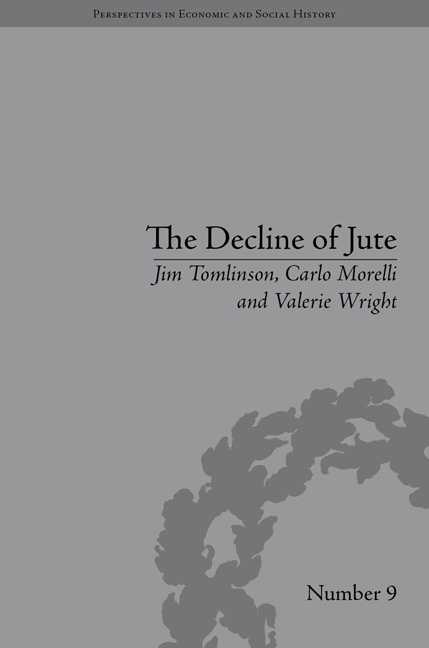Book contents
- Frontmatter
- CONTENTS
- Dedication
- Acknowledgements
- Abbreviations
- List of Figures and Tables
- Introduction
- 1 The Story up to 1939
- 2 De-Globalization and Decline, 1939–99
- 3 The Industry and its Workforce
- 4 Defending the Domestic Industry
- 5 Firms’ Responses to the Decline of the Industry
- 6 Influencing Government
- 7 The Decline of Jute and the Economic Health of Dundee
- Conclusions
- Notes
- Works Cited
- Index
5 - Firms’ Responses to the Decline of the Industry
- Frontmatter
- CONTENTS
- Dedication
- Acknowledgements
- Abbreviations
- List of Figures and Tables
- Introduction
- 1 The Story up to 1939
- 2 De-Globalization and Decline, 1939–99
- 3 The Industry and its Workforce
- 4 Defending the Domestic Industry
- 5 Firms’ Responses to the Decline of the Industry
- 6 Influencing Government
- 7 The Decline of Jute and the Economic Health of Dundee
- Conclusions
- Notes
- Works Cited
- Index
Summary
As previously demonstrated, the decline of the Dundee jute industry had emerged by the first decades of the twentieth century. Only the introduction of Jute Control in 1939 succeeded in providing the industry with any measure of protection from international competition. At the end of the Second World War these competitive pressures re-emerged, resulting in the continuation of pre-war and wartime protection for the jute industry. Aided by the continuation of this protection, the post-war decades, until the 1970s, can be understood as ones of relative prosperity for the industry. Under Jute Control the industry underwent significant specialization into protected, higher-quality product markets. This was associated with changes in production processes in the form of increasing capital intensity, and an associated move away from a concentration on female labour. The main argument in this book is therefore that this decline was in many ways successfully managed in the period from the end of the Second World War until the final ending of Jute Control. The diminution of the industry thus took place simultaneously within the wider crisis in British manufacturing of that decade and, especially, the subsequent recession of 1980–1. In Scotland, and Dundee specifically, this was also reflected in the closure of newer manufacturing industry associated with the growth of foreign direct investment in the earlier decades.
- Type
- Chapter
- Information
- The Decline of JuteManaging Industrial Change, pp. 93 - 118Publisher: Pickering & ChattoFirst published in: 2014



